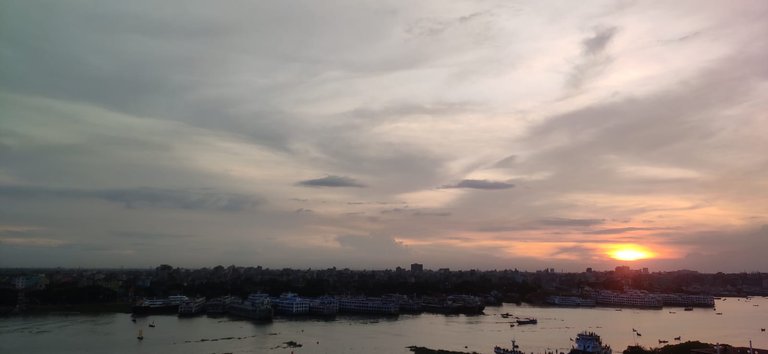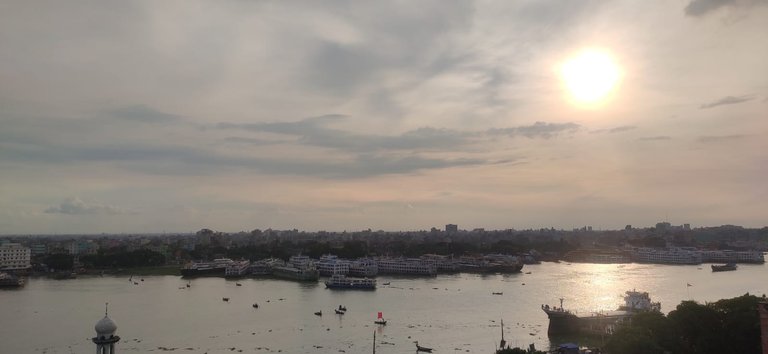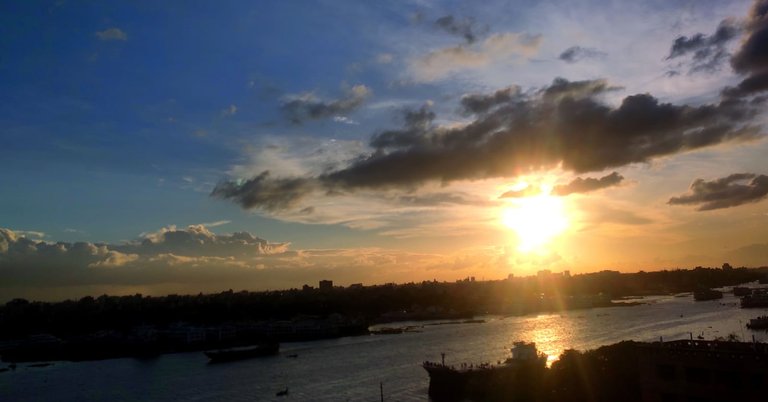Hi there!
Sending you warm greetings and good vibes. Previously I've shared my introduction and traveling post. Today I'll talk about a famous river in my country. The river's name is Buriganga River.

Buriganga is the only river which one is located in Dhaka
At the beginning of the 17th century, Dhaka, the capital of Bangladesh, was built on the banks of the Buriganga River.
Buriganga river joins Balu, Turag, Tongikhal and Shitalakshya rivers.
Many canals within Dhaka connect with this river.

Over the past several years, the river’s length has diminished from 27 km to 18 km due to siltation and encroachment: 11km of the remaining river flow through Dhaka District, and 7 km are in Narayanganj District with a very small portion at the river’s terminus in Munshiganj.
Despite its role in Dhaka and Bangladesh's development, it is the country's most polluted river.
As a result of pollution, the river is almost dead.
Riverkeeper has been working since 2009 to protect the Buriganga, but there are many factories in the vicinity of the river and their wastes are dumped into the river, so it has not been possible to clean the river so far.
Originating from the Dhaleshwari River through the Karnataka tributary, the Buriganga average width and depth are 400m and 10m respectively.
The downstream junction with the Dhaleshwari fluctuates from time to time according to changes in the position of the latter river. Its course by Dhaka is stable, fixed by the resistant clays.
There are two bridges on this river, one is Postogola Bridge and the other is Babubazar Bridge. These are many famous bridges of Dhaka.
Numerous boats launch ship trawlers in this river every day.

Ancient Period
- The areas around the Buriganga River have been inhabited for thousands of years. The river continues to play an important role in Bengal's early history, serving as an important waterway for trade and commerce. The ancient city of Bikrampur (now Munshiganj) was established on the banks of this river and served as an important center of trade and culture.
Mughal Period
- During the Mughal period in the 17th century, Dhaka became the regional capital of Bengal and the Buriganga River became more prominent. Mughal emperors, especially Emperor Jahangir, recognized the river's strategic importance and developed it as a major trade route. Numerous palaces, gardens, and important buildings were built on its banks.
British Colonial Era
- In the 18th and 19th centuries, Bangladesh came under British colonial rule and Dhaka became an important administrative center. The Buriganga River continues to serve as a major waterway for trade and transport, with steamships and boats plying its waters. However, due to rapid urbanization and industrialization, the river and its surrounding areas have faced gradual degradation.
Environmental Challenges
- In the 18th and 19th centuries, Bangladesh came under British colonial rule and Dhaka became an important administrative center. The Buriganga River continues to serve as a major waterway for trade and transport, with steamships and boats plying its waters. However, due to rapid urbanization and industrialization, the river and its surrounding areas have faced gradual degradation.
Efforts for Restoration
- Recognizing the critical condition of the Buriganga River, various initiatives have been taken to restore its health and preserve its historical significance. The government of Bangladesh, along with international organizations and local communities, has implemented projects to reduce pollution, relocate polluting industries, and restore the river's ecosystem. Efforts are ongoing to revive the river's water quality and promote sustainable development along its banks.
Cultural Significance
- The Buriganga River is not only a physical lifeline but also holds immense cultural value for the people of Bangladesh. It has been a muse for poets, writers, and artists, inspiring numerous works of literature, music, and visual arts. The river is also an integral part of traditional festivities, with boat races and festivals held on its waters during special occasions.

In conclusion, the Buriganga River in Bangladesh has a rich history that spans centuries. It has played a pivotal role in the trade, culture, and development of the region, particularly during the Mughal period and the British colonial era. However, the river has faced significant environmental challenges, including pollution and degradation, due to urbanization and industrialization.
Efforts are being made to restore the health of the Buriganga River, with initiatives focused on reducing pollution, relocating industries, and restoring its ecosystem. The government, along with international organizations and local communities, is working towards improving the water quality and preserving the river's historical and cultural significance.
The Buriganga River remains an integral part of Bangladesh's identity, inspiring artists, writers, and traditional festivities. As ongoing restoration efforts continue, it is hoped that the river's glory will be revived, ensuring its sustainable future for generations to come.
Congratulations @mohammadrefat! You have completed the following achievement on the Hive blockchain And have been rewarded with New badge(s)
Your next target is to reach 300 upvotes.
You can view your badges on your board and compare yourself to others in the Ranking
If you no longer want to receive notifications, reply to this comment with the word
STOPCheck out our last posts: